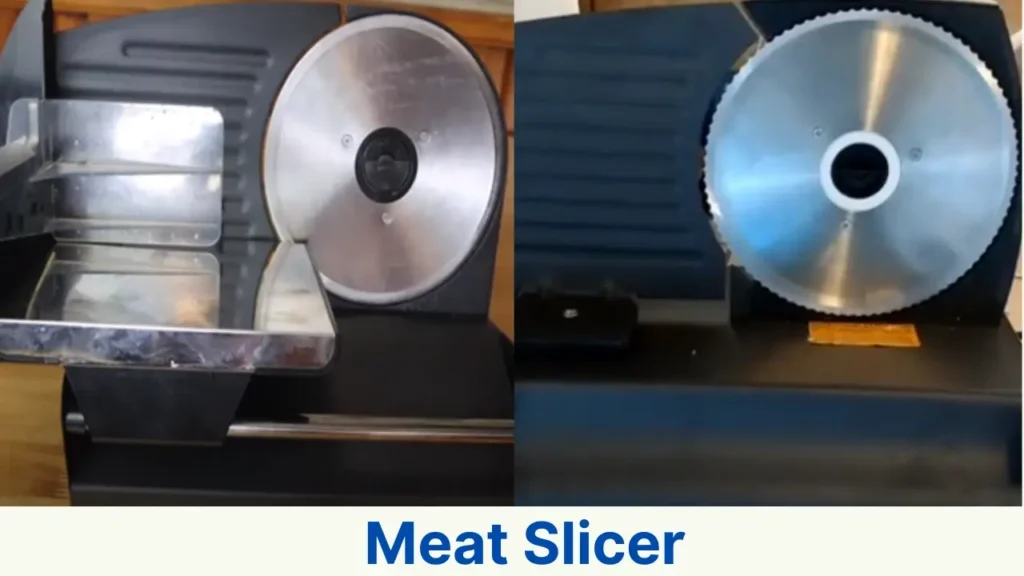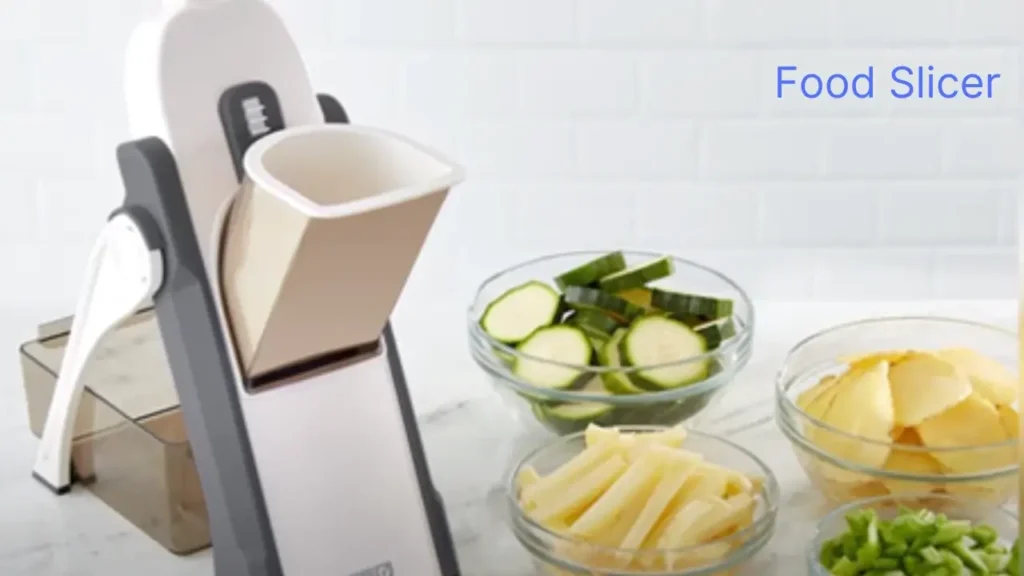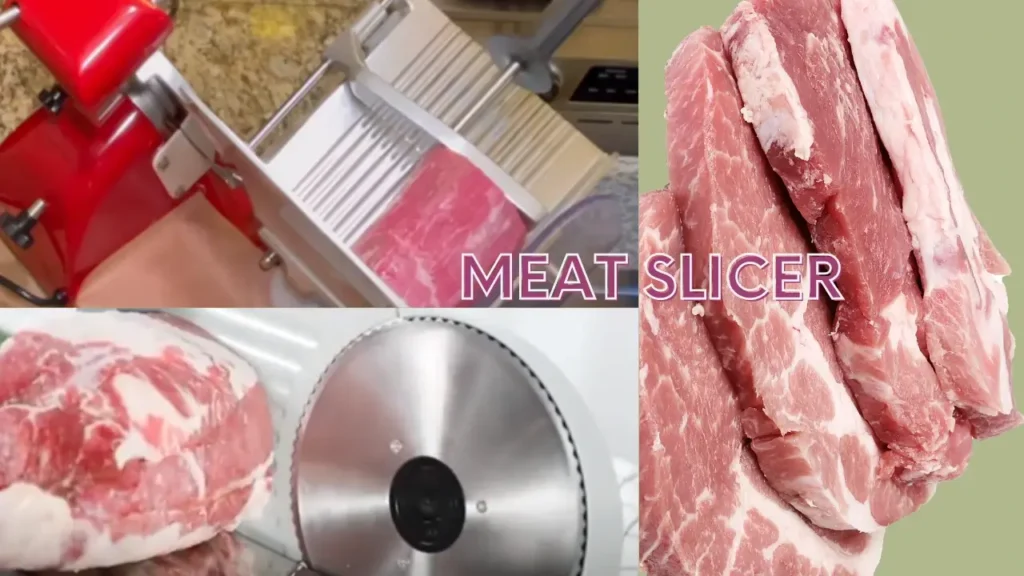A food slicer is a kitchen tool used to piece different types of foods, such as bread, cheese, vegetables, and fruits. It’s an important part of a kitchen. Without this the kitchen is incomplete.
It usually consists of a rotating blade that is applied to the base and can be adjusted to the food in various thicknesses. Some food slices also have deductions, greetings, and Julienning Eating ATC.
- Difference Between Food Slicer and Meat Slicer:
- Food slicer:
- Description of the parts and features of a common food slicer:
- Examples of foods that can be sliced with a food slicer:
- Tips for using and maintaining a food slicer:
- Meat slicer:
- Description of the parts and features of a common meat slicer:
- Examples of meat that can be cut off with meat slices:
- Tips for using and maintaining a meat slicer:
- In the end, Follow the food safety guidelines:

On the other hand, a meat slicer is a special device that is specifically designed for pieces, such as Daily Meat, Ham, Turkey, Roast Cow Meat, etc. It usually has a big and more powerful blade.
It is designed to handle a steady consistency of the meat. These Meat slicers may have a more robust and durable construction because they are intended for commercial use in delis, butcher shops, and restaurants.

Difference Between Food Slicer and Meat Slicer:
| Feature | Food Slicer | Meat Slicer |
| Blade size | Smaller | Larger |
| Power | Used less power | Used more power |
| Establishment | Used less area | Used more area |
| Types of food sliced | Wide range | Wide range |
| Purpose of use | Home | Home & Commercial |
Food slicer:
Food slices are usually smaller, less powerful, and less durable than meat slices, and they are suitable to collide with wide food items, including bread, cheese, vegetables, and fruits.


Food slices are the same tools for domestic chefs and professionals, as they allow permanent pieces of a wide range of food. They can save time and effort than hand-pieces, and they can produce more uniform slices that can be more aesthetically pleasing in the vessels.
Food slices can be manual or electric, and they can come with cutting, greeting, and juggling food additional attachments. Some food slices are designed for use in the commercial kitchen, while other home use is suitable
Description of the parts and features of a common food slicer:
Blade:
The blade is the most important part of the food slicer, as it is responsible for pieces of food. The blades are usually made of stainless steel or other durable materials and depend on the type of food they can be served or non-server. The blade is usually applied to a shaft or arm that rotates through it pushing the food.
Base:
The base is the base of the slick and supports other parts of the devices. It can be made of metal, plastics, or other materials and can contain non-slip feet to keep the slicer stable on the countertop.
Carriage:
The carriage is a tray or platform of the slicer that holds the food being sliced. It may be made of metal, plastic, or other materials. The type has a slotted or grooved surface to guide the food as it is pushed through the blade.
Food pusher:
A food pusher is a tool that is used to hold the food in place and guide it through the blade as it is being sliced. It may be made of metal, plastic, or other materials and may have a handle for easy gripping.
Thickness adjustment knob:
Most food slicers have a knob or lever that allows the user to adjust the thickness of the slices. The blade can be moved closer to or farther away from the carriage to achieve different slice thicknesses.
On/off switch:
Food slicers typically have an on/off switch or button to activate the blade. Some slicers may also have a safety switch or lock to prevent accidental activation of the blade.
Additional attachments:
Some food slicers come with additional attachments for shredding, grating, and julienning food. These attachments may be easily interchangeable and may be useful for preparing a variety of dishes.
Motor:
Food slicers may be manual or electric. Electric slicers typically have a motor that powers the blade, while manual slicers rely on the user to turn the blade manually. Electric slicers may be more powerful and efficient, but manual slicers may be more portable and easier to store.
Examples of foods that can be sliced with a food slicer:
Bread:
Food slicers can be used to slice bread into uniform slices for sandwiches, toast, or other dishes.
Cheese:
Food slicers can be used to slice cheese into thin or thick slices, depending on the desired use. Sliced cheese can be used in sandwiches, on top of crackers or bread, or as a topping for salads or other dishes.
Vegetables:
Food slicers can be used to slice vegetables such as cucumbers, carrots, bell peppers, and onions into thin or thick slices for salads, sandwiches, or other dishes.
Fruits:
Food slicers can be used to slice fruits such as apples, pears, and mangoes into thin or thick slices for snacking, salads, or other dishes.
Keep in mind that food slices are not suitable for all kinds of food. It can be more difficult to cut these foods than others. It is important to follow the manufacturer’s instructions and safely use the slicer to prevent injury.
Tips for using and maintaining a food slicer:
Use a steady, even pressure:
When you eat with a food slicer, it is important to use stable, even pressure to ensure that the pieces are the same and avoid slicers or food damage.
Clean the slicer after each use:
It is important to clean the slicer after each use to prevent bacteria from growing on the blade or other parts of the appliance. Use a damp cloth or sponge to wipe down the slicer, and be sure to dry it thoroughly before storing it.
Sharpen the blade as needed:
Over time, the blade of a food slicer may become dull, which can result in uneven slices or difficulty slicing certain foods. If this happens, you may need to sharpen the blade or replace it. Follow the manufacturer’s instructions.
Store the slicer safely:
When not in use, be sure to store the slicer in a safe place where it is out of reach for children and pets. It is also a good idea to unplug the slicer if it is electric to prevent accidents.
Inspect the slicer regularly:
Regularly inspect the slicer for any signs of wear or damage. If you notice any issues, such as a loose blade or a damaged cord, stop using the slicer and contact the manufacturer or a professional for repair or replacement.
Meat slicer:
Meat slices are large, more powerful, and more durable, and are specifically designed for pieces of meat. They usually intend for commercial use.

Description of the parts and features of a common meat slicer:
Blade:
The blade is the most important part of the meat slick, as it is responsible for pieces of meat. The blades are usually made of stainless steel or other durable materials and depending on the type of meat harvesting they can have a character or are non-serrated. The blade is usually applied to a shaft or arm that rotates the meat as it pushes it. The meat slick blades are usually larger and more powerful than those found on food sailors.
Base:
The base is the base of the meat slices and supports other parts of the equipment. It can be made of metal, plastic, or other materials and can contain non-slip feet to keep the slicer stable on the countertop. Meat slices are generally stronger and more sustainable than those found on food slicers because they are for commercial use.
Carriage:
The carriage is a tray or platform that holds the meat being sliced. It may be made of metal, plastic, or other materials and typically has a slotted or grooved surface to guide the meat as it is pushed through the blade. Meat slicer carriages are typically larger and more durable than those found on food slicers, as they are intended for handling larger cuts of meat.
Meat pusher:
A slicer is a tool used to hold the meat and guide it through the blade for the purpose of a meat slice. It can be made of metal, plastic, or other materials and can easily have a handle of grip. Different types of meat in meat slices can have different poppers, such as a long, slim passenger and wider pieces of roasts to pieces of daily meat.
Thickness adjustment knob:
Most meat slicers have a knob or lever that allows the user to adjust the thickness of the slices. The blade can be moved closer to or farther away from the carriage to achieve different slice thicknesses.
On/off switch:
Meat slicers typically have an on/off switch or button to activate the blade. Some slicers may also have a safety switch or lock to prevent accidental activation of the blade.
Additional attachments:
Some meat slicers come with additional attachments for shredding, grating, and julienning meat. These attachments may be easily interchangeable and may be useful for preparing a variety of dishes.
Motor:
Meat slicers may be manual or electric. Electric slicers typically have a motor that powers the blade, while manual slicers rely on the user to turn the blade manually. Electric slicers may be more powerful and efficient, but manual slicers may be more portable and easier to store. Meat slicer motors are typically more powerful than those found on food slicers, as they are designed to handle the denser consistency of meat.
Examples of meat that can be cut off with meat slices:
Deli meats:
Meat slicers are often used to slice deli meats such as ham, turkey, roast beef, and salami into thin or thick slices for sandwiches, salads, and other dishes.
Roasts:
Meat slicers can be used to slice cooked roasts such as beef and lamb into thin or thick slices for sandwiches, stir-fries, or other dishes.
Poultry:
Meat slicers can be used to slice cooked poultry such as chicken and turkey into thin or thick slices for sandwiches, salads, and other dishes.
Game meats:
Meat slicers can be used to slice cooked game meats such as venison and elk into thin or thick slices for sandwiches, stir-fries, or other dishes.
Keep in mind that every piece of meat is not suitable, and some meat can be more difficult to piece than others. It is important to follow the manufacturer’s instructions and safely use the slicer to prevent injury.
Tips for using and maintaining a meat slicer:
Follow the manufacturer’s instructions:
Reading and following the manufacturer’s instructions when using a food slicer. This will ensure that you are using the slider safely and properly and will also help you to benefit from your luggage.
Use a steady, even pressure:
When you eat with a meat slicer, it is important to use stable, even pressure to ensure that the pieces are the same and avoid slicers or meat damage.
Keep the slicer clean:
It is important to clean the slicer after each use to prevent bacteria from growing on the blade or other parts of the appliance. Use a damp cloth or sponge to wipe down the slicer, and be sure to dry it thoroughly before storing it.
Sharpen the blade as needed:
Over time, the blade of a meat slicer may become dull, which can result in uneven slices or difficulty slicing certain meats. If this happens, you may need to sharpen the blade or replace it. Follow the manufacturer’s instructions.
Store the slicer safely:
When not in use, be sure to store the slicer in a safe place where it is out of reach for children and pets. It is also a good idea to unplug the slicer if it is electric to prevent accidents.
Inspect the slicer regularly:
Regularly inspect the slicer for any signs of wear or damage. If you notice any issues, such as a loose blade or a damaged cord, stop using the slicer and contact the manufacturer or a professional for repair or replacement.
In the end, Follow the food safety guidelines:
When using a meat slicer, it is important to follow proper food safety guidelines to prevent the risk of foodborne illness. This includes washing your hands before and after handling meat, keeping raw and cooked meats separate, and storing meats at the proper temperature. It is also a good idea to clean and sanitize the slicer before and after slicing raw meat.
Frequently Asked Questions?
Can a food slicer be used to slice meat?
Some food slicers may be able to slice some types of meat, although specialized meat slicers are typically more suitable for this purpose due to their larger, more powerful blades. It is important to follow the manufacturer’s instructions and use the slicer safely to avoid injury and ensure that the slices are uniform.
Can a meat slicer be used to slice other types of food?
Meat slicers may be able to slice some types of food other than meat, such as bread, cheese, vegetables, and fruits. However, they are not as versatile as food slicers and may not be suitable for all types of food due to their larger, more powerful blades. It is important to follow the manufacturer’s instructions and use the slicer safely to avoid injury and ensure that the.
Can a meat slicer slice cheese?
Yes, it is possible for a meat slicer to slice cheese, although specialized cheese slicers are typically more suitable for this purpose due to their smaller, more precise blades. Cheese can be difficult to slice with a meat slicer due to its softer consistency, and it may require more effort to push it through the blade. Additionally, cheese may stick to the blade more easily than meat, which can make it harder to clean the slicer after use.
Can you slice potatoes with a meat slicer?
It is possible to slice potatoes with a meat slicer, although it may be more challenging than slicing other types of food due to the denser consistency of potatoes. Meat slicers have larger, more powerful blades than food slicers, which may make them more suitable for slicing potatoes. However, it is important to follow the manufacturer’s instructions and use the slicer safely to avoid injury and ensure that the slices are uniform.
